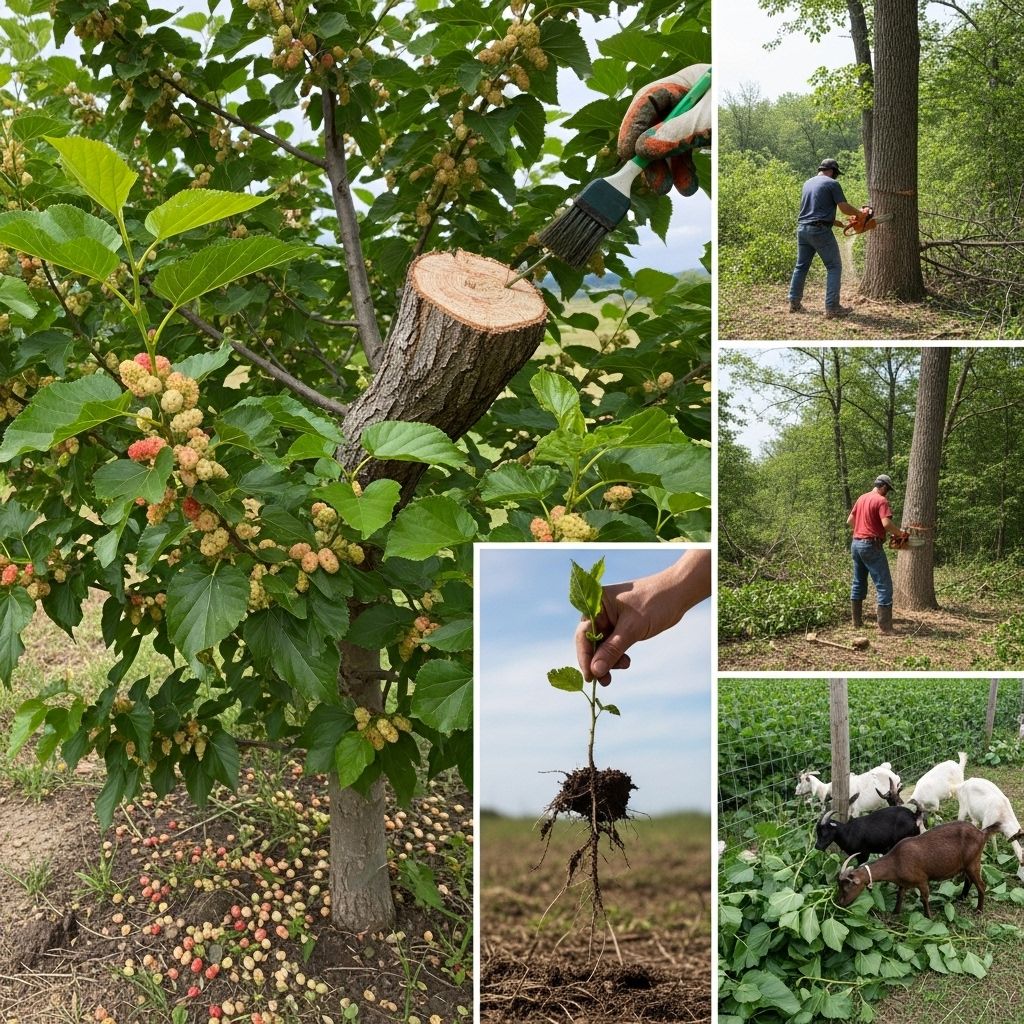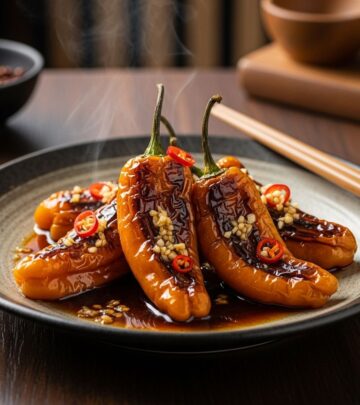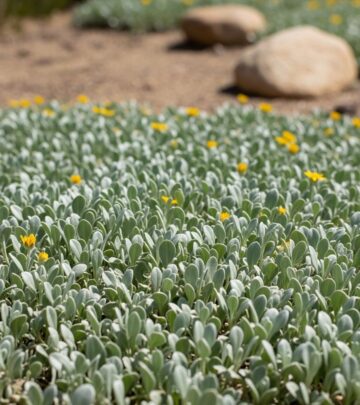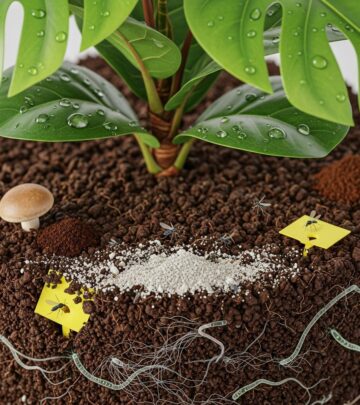White Mulberry Invasive Species: 4 Proven Control Methods
A comprehensive guide to identifying, managing, and understanding the ecological impacts of the invasive white mulberry tree in North America.

Image: HearthJunction Design Team
Understanding the White Mulberry: Origins and Invasiveness
The white mulberry (Morus alba) is a fast-growing, deciduous tree native to China. Originally introduced to North America during colonial times to support a burgeoning silk industry, white mulberry has since escaped cultivation and naturalized across a vast range. While valued for its fruit, rapid growth, and adaptability in its homeland, in North America this tree has become one of the most persistent and problematic invasive species, threatening biodiversity and native tree populations.
White Mulberry at a Glance
- Scientific name: Morus alba
- Family: Moraceae
- Origin: China
- Typical height: 30–50 feet
- Habitats invaded: Forest edges, disturbed forests, roadsides, urban lots, open fields
- Growth form: Deciduous tree with rounded crown
Why Was White Mulberry Introduced?
White mulberry was first brought to North America in the 1700s with the hope of establishing a domestic silk industry. The tree’s leaves are the primary food source for the silkworm (Bombyx mori), which spins the valuable silk threads. Although the silk industry never flourished in North America, white mulberry quickly spread beyond cultivation, taking root in diverse landscapes from the eastern seaboard through the Midwest and beyond.
Distribution and Habitat
White mulberry is now widespread throughout the continental United States, occurring in every state except Nevada. It thrives in both urban and rural environments and is particularly common in:
- Old fields
- Roadsides
- Forest edges
- Disturbed urban lots
- Open and disturbed forests
Its tolerance of a broad range of soil types—including sandy, clay, and loam—and ability to outcompete native vegetation make it especially pervasive in mild to subtropical climates.
Ecological and Environmental Threats
White mulberry poses a significant threat to native ecosystems in several ways:
- Displacement of native species: Its rapid growth and dense canopy shade out native plants, reducing biodiversity.
- Hybridization: It crossbreeds with the native red mulberry (Morus rubra), producing hybrids that threaten genetic purity and long-term survival of the native species.
- Soil and ecosystem disruption: Its root systems and leaf litter can alter soil composition and nutrient cycling, further disadvantaging native flora.
- Pest and disease host: The tree can harbor pests and diseases transmissible to both native trees and cultivated crops.
Identification: How to Recognize White Mulberry
Distinguishing white mulberry from similar species is crucial for land managers and gardeners. Key characteristics include:
- Leaves: Broadly variable in shape; can be oval, heart-shaped, or deeply lobed (up to three lobes). Glossy and dark green on top; pale and slightly hairy beneath. Turn pale yellow in fall.
- Bark: Young bark is brownish-orange with characteristic lenticels (small raised pores). Older trunks develop a grayish hue with irregular cracks and fissures.
- Fruit: Multiple-seeded berries ranging from white to pink to deep purple/black. Edible for wildlife (and humans) but prolific in seed dispersal.
- Growth form: Rounded crown, usually 30–50 feet tall at maturity.
| Feature | White Mulberry (M. alba) | Red Mulberry (M. rubra) |
|---|---|---|
| Leaf Surface | Glossy, usually smooth on top | Rough, sandpapery on top |
| Bark | Bright orange-brown on new wood; gray and cracked with age | Dark brown, deeper fissures with age |
| Fruit Color | White, pink, or purple-black | Dark purple to almost black |
| Height | 30–50 feet | 35–60 feet |
Common Problems and Concerns
In addition to ecological disruption, white mulberry introduces several practical and horticultural challenges:
- Structural Weakness: Prone to splitting due to included bark—where two stems grow at a tight angle and fail to fuse properly. This can result in trunk or branch failure during storms or high winds.
- Messy Fruit Drop: The abundant fruit stains sidewalks, patios, and attracts birds—and, by extension, their droppings.
- Vigorous Resprouting: Even after being cut down, stumps can resprout aggressively, requiring persistent management.
- Allergen Production: Pollen from male trees is a known allergen.
Control and Management Strategies
Efforts to manage white mulberry focus on both removing existing trees and preventing further spread. Effective strategies include:
- Hand Pulling: Seedlings and small saplings can be pulled by hand. Ensure removal of the entire root system to prevent regrowth.
- Cut Stump Treatment: For larger trees, cut close to the ground and immediately treat the fresh stump with a systemic herbicide such as glyphosate to prevent resprouting. Stump grinding is another effective measure.
- Girdling: For sizable specimens, girdle the trunk by removing a strip of bark and cambium around the circumference to interrupt the flow of nutrients and kill the tree over time.
- Regular Monitoring: Sites with existing mulberry infestations should be regularly monitored for new seedlings and regrowth for several years after removal operations.
Important Note: Always follow local regulations and label instructions when applying herbicides. Non-chemical options are preferable in sensitive habitats or areas with high native plant diversity.
Recommended Native Alternatives
When replacing white mulberry or planning new plantings, consider native tree species that offer wildlife benefits without the invasive risk:
- Red mulberry (Morus rubra): Closely related, provides similar habitat and fruit for wildlife.
- Red maple (Acer rubrum): Attractive foliage and adaptable to a wide range of sites.
- Serviceberry (Amelanchier spp.): Offers edible berries and showy spring flowers.
- Eastern redbud (Cercis canadensis): Ornamental pink blossoms and good for pollinators.
- Hackberry (Celtis occidentalis): Hardy, wildlife-friendly option for urban and rural landscapes.
Living With White Mulberry: Is It Ever Useful?
Despite its reputation as a nuisance, white mulberry does serve certain functions:
- Fruit production: The berries are edible for both humans and wildlife. In some cultures, the leaves are used medicinally or as animal fodder.
- Silkworm rearing: Essential for silk production (though commercial silk farms in North America are virtually nonexistent).
However, these benefits are far outweighed by the ecological costs in non-native environments. Responsible management and replacement with native species are the best long-term strategies for gardeners, landowners, and public agencies.
Prevention: Keeping White Mulberry Out of Your Landscape
- Avoid planting: Do not plant white mulberry trees; opt for native alternatives.
- Remove existing trees: Promptly eradicate young trees and seedlings before they mature and set seed.
- Dispose of yard waste responsibly: Ensure mulberry prunings do not take root in compost or brush piles.
- Educate neighbors and community: Raise awareness about the risks of invasive species and the importance of native plants.
Table: Comparing White and Red Mulberry
| Characteristic | White Mulberry (M. alba) | Red Mulberry (M. rubra) |
|---|---|---|
| Leaf Texture | Glossy, smooth on top | Rough, sandpapery feel |
| Fruit Color | White, pink, black | Dark purple to black |
| Native Range | China (introduced to N.A.) | Eastern North America |
| Invasiveness | Yes | No |
Frequently Asked Questions (FAQs)
What is the main ecological impact of white mulberry?
White mulberry displaces native plant species, especially in forest edges and disturbed habitats, leading to reduced biodiversity and potential hybridization with native red mulberry.
Can white mulberry be controlled without chemicals?
Yes. Small seedlings can be pulled by hand, and girdling or repeated cutting can kill larger trees over time. Persistent monitoring is crucial, as stumps may resprout.
Is the fruit of white mulberry edible?
Yes; the fruit is edible for both humans and wildlife. However, consumption should be limited if the tree has been treated with herbicides.
How can I tell white mulberry from red mulberry?
White mulberry typically has glossy, variable leaves that are often smoother and lighter in color, while red mulberry leaves are rough with a deeper green. Fruit color and bark characteristics are also helpful identifiers.
Should I remove a white mulberry tree from my property?
Yes. Removing white mulberry is generally recommended to prevent further spread and protect native species. Replace with a native tree suited to your local ecosystem.
Conclusion: Protecting Native Landscapes
White mulberry is a textbook example of an introduced species gone awry. Its unchecked proliferation threatens native forests, parks, and urban green spaces. By learning how to identify, remove, and replace white mulberry with resilient native species, gardeners and land stewards can help restore vital ecological balance and preserve local plant diversity for future generations.
References
- https://www.invasive.org/alien/pubs/midatlantic/moal.htm
- https://www.invasiveplantatlas.org/subject.cfm?sub=6050
- https://www.tdworld.com/vegetation-management/article/21262287/invasive-watch-mulberry
- https://dnr.wisconsin.gov/topic/Invasives/fact/WhiteMulberry
- https://moreleaf.org/tree-of-the-week-white-mulberry/
Read full bio of Anjali Sayee












